| This article originally appeared in the Sesquicentennial 1834-1984, East Liverpool, Ohio Booklet. |
East Liverpool's Volunteer Military Units
by: Timothy R. Brookes
Until the twentieth century forever dispelled the concept of war as an exciting, glamorous adventure, the outbreak of armed conflict was generally wel-comed by the very people who were most likely to suffer its consequences. The residents of East Liverpool were no exception to this rule and the city has a long, but little known, record of enthusiastically and promptly sending her sons off to war.
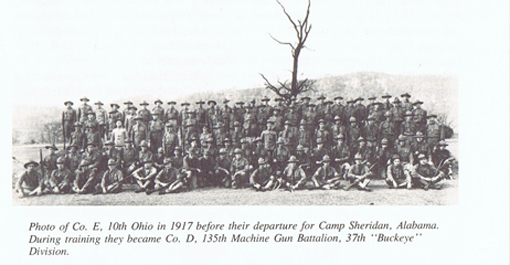
Unlike recent wars, in which the responsibility for forming the nation's military forces was left entirely to the federal government, the wars of the Nineteenth Century and to a lesser extent, World War One, were dependent on state and local efforts to find, enroll and train America's citizen soldiers. A city the size of East Liverpool was expected to and did organize complete companies from the local population.
The Civil War is the first conflict for which sufficient documentation exists concerning local volunteer units. East Liverpool, though little more than a village, provided recruits to a large number of regiments, including many Pennsylvania units. Of particular interest, however, are the two companies that were recruited entirely within the city.
The first such company was organized during late July and early August, 1862. By then, the war was more than a year old and the numerous Union setbacks led to the realization that the Southern Confederacy was quite serious about its demands for independence. The early optimism of many in the North had faded - as had the unthinking rush to the colors of the volunteers of 1861.
As a result, recruiting in the summer of 1862 was not easy and generally re-quired the personal dynamism of a local politician or businessman who could attract potential volunteers. East Liverpool was fortunate in having an ambitious lawyer named Harrington R. Hill, who felt the call to preserve the Union. Hill, a son of Sanford C. Hill, was practicing law in Iowa when the war began but soon returned to East Liverpool. A recruiting broadside dated 6 August 1862, urged local men to: "Enlist! A full company can be raised for Col. J.W. Reilly's 104th Regt. in Liverpool and St. Clair Twps. and thus, if possible, ob-viate the necessity for a draft". A meeting was held in Calcutta on 7 August and featured "able speakers" as well as the Liverpool Brass Band and "H.R. Hill- Lieutenant". Apparently these patriotic blandishments proved successful, as the enlistment book of the company shows that nearly all of the men were enlisted during the second week of August. The men called themselves the "Liverpool Tigers" prior to their official assignment.
It seems especially unfortunate that the City's first newspaper, The East Liver-pool Mercury, published it last issue on 31 July 1862 - at the same time that Hill's recruiting efforts were getting underway. The Wellsville Patriot, however, re-ported on 19 August 1862 that the East Liverpool company had taken the train from Wellsville to Camp Massillon after an emotional send off by friends and relatives.
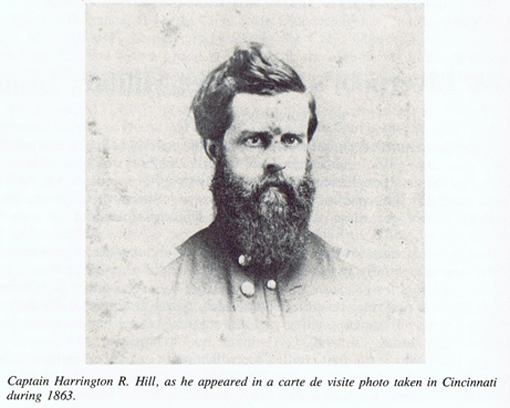
When the E.L. Company reached Camp Massillon, they learned that the 104th Ohio had been filled and as a result the "Liverpool Tigers" became Co. A of the 115th Ohio which was just then being organized. As the officer of an entire company, H.R. Hill received a commission as a captain.
While in camp, the men would have learned the intricate drill and maneuvers that were essential to armies which still fought shoulder to shoulder in lines of battle. The quartermaster's records of Co. A show that blankets, coats, caps, pants, tents, canteens, haversacks, cartridge boxes, belts and other necessary ac-coutrements were issued to each of the new soldiers. They were armed with Austrian muskets, which must have caused considerable dissatisfaction as that particular type was a cast-off from European armies which American arms dealers bought to help fill the huge demand for weapons.
Eventually, the regiment received its orders but it is doubtful that the nature of the assignment was pleasing to the combat-ready members of the Liverpool Tigers. The 115th Ohio's ten companies were divided and part of the regiment was sent to guard Confederate prisoners at Camp Chase in Columbus. The balance of the regiment, including Co. A., was sent to Cincinnati where they served as garrison troops until October, 1863.
Even with such relatively safe duty, the men of Co. A still suffered losses from disease and accidents. Six men from East Liverpool died from disease without ever leaving the state. Private Jacob Maple is listed as having been accidentally shot at Cincinnati on 20 June, 1863 - though nothing more is known of the cir-cumstances of his death.
When Morgan's raiders passed near Cincinnati in July, 1863, the 115th at-tempted unsuccessfully to intercept them. in a letter from his mother after Morgan's capture near West Point, Hill was probably further frustrated by her comment, "If you had caught Morgan at Cincinnati, we would have been saved a dreadful scare".
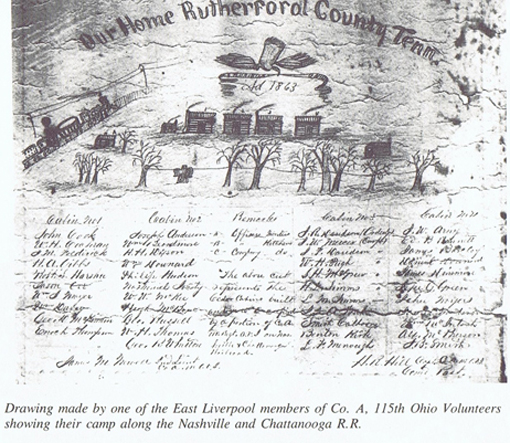
Finally in October, 1863, the 115th was ordered to proceed to Chattanooga, Tennessee and then to Murfreesboro where once again they were assigned to guard duty. For the remainder of the war they served in widely scattered fortifications along the Nashville and Chattanooga R.R. Approximately 200 men from the 115th were captured in 1864 by Confederate General Nathan B. Forrest when his forces attacked a number of the small log and earth forts that the men had constructed.
None of those captured were from Co. A, and, in fact, none of the East Liver-pool soldiers lost their lives as a result of enemy action.
Hill ended the war as a Lieutenant-Colonel and was mustered out with his men on 22 June 1865.
East Liverpool's other company-sized contribution to the Civil War was a short-term unit called up for 100 days service during the summer of 1864. The 143rd Ohio Volunteer Infantry was formed from units of the Ohio militia that had not been called to federal service. William H. Vodrey of East Liverpool was a member of the state militia and had organized a company of approximately 100 men in this city. Vodrey was made Colonel of the regiment which was organized at Camp Chase, Columbus, on 13 May 1864.
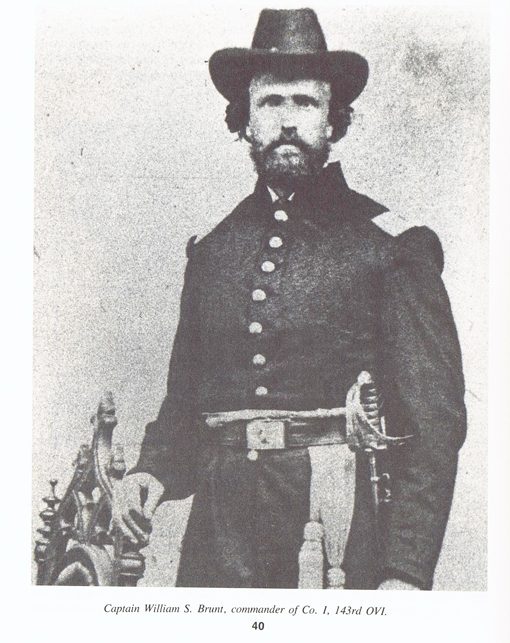
The East Liverpool contingent, Co. I, had a roster that reads like a who's who of the local pottery industry. William Brunt served as Captain, While George Morley and John N. Taylor were lieutenants. Enlisted men who were, or would be, prominent in the ceramics trade included Henry Brunt, William and Samuel Cartwright, Cassius C. Thompson, and Benjamin Harker. Many of the other men in Co. I were also potters.
The 143rd was never assigned to serve in the front lines but was intended to relieve other units for more dangerous roles. Accordingly, the 143rd OVI did garrison duty in the forts surrounding Washington, D.C., and for a time at City Point, Virginia.
The service record of the regiment was unremarkable, although three city men died of disease. Apparently, some of East Liverpool's 100 day warriors were less than enthusiastic. In late August, Colonel Vodrey wrote to his brother, James, at home,
"There is nothing like a tour in the army for finding out what men are made of. We have some of the worst specimens of humanity from Liverpool that can be found this side of Hell. Men who, when at home and not called upon to make any sacrifice, were the most blatant union men we had in the town are now the most violent copperheads and traitors either North or South."
The regiment was mustered out on 13 September 1864 after the expiration of its term of service and returned to peaceful pursuits in East Liverpool.
Not until "the splendid little war" of 1898 would East Liverpool be given another opportunity to exhibit its martial spirit. In the thirty-three years after Ap-pomattox, the memory of war's true costs had dimmed and, quite frankly, the U.S. was spoiling for a fight. The Review evidenced the war fever prevailing thoughout the country and spoke with approval of the U.S. "ordering the Dons to get out of Cuba".
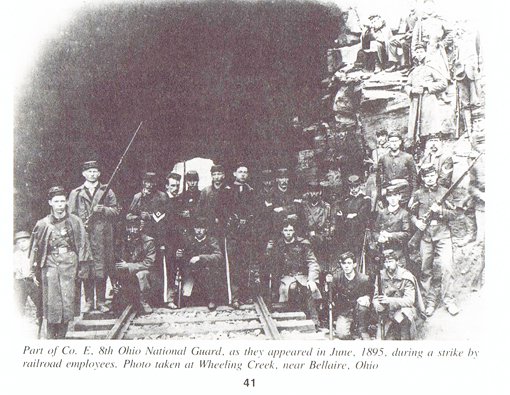
Unlike the Civil War, the city already had a military company in existence. Co. E of the 8th Ohio National Guard had been organized in 1891-2, but was understrength at the time hostilities threatened with Spain. Once again, a member of the Hill family was in command. William M. Hill, a son of H.R. Hill, was the captain of Co. E and was busy enlisting additional recruits. On 21 April 1898, the newspaper reported that 13 new men had "signed the roll" that day, including 11 potters, one laborer and a baker.
The enthusiasm shown here before Co. E's departure probably far surpassed any excitement that the men saw while in active service. When war was declared on Spain, Captain Hill and his men took part in a impromptu parade led by the Manley Band which drew hundreds of spectators.
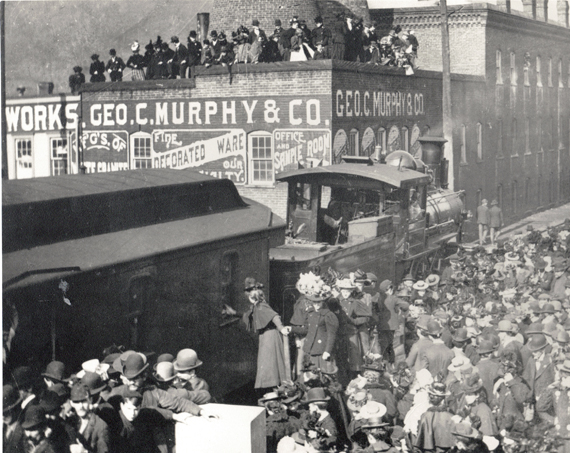
Co. E. Leaving for Spanish-American War from glass plate taken by Harry Webb. April 25, 1898.
On the day that the company was ordered to entrain, the entire city turned out to cheer the men. On the march to the station, though a crowd estimated at 10,000, the Haines and Manley bands played "The Girl I Left Behind Me". As the men boarded the passenger cars, the bands broke into "Hail Columbia" while the Sons of Veterans fired a salute. Despite the impressive send-off, military glory eluded the men of Co. E. By the time of their landing in Cuba on 10 July, the actual fighting was over. Co. E was assigned to duty in the trenches where more than half the soldiers contracted malaria, yellow fever, or typhoid. Five members of the company died as a result of disease - none from enemy action. The sur-vivors returned to the city on 8 September 1898 after 4' months service, in-cluding 37 days in Cuba.
The last military unit to be recruited exclusively in East Liverpool was organiz-ed during the early days of U.S. participation in World War One. On 18 May 1917, The Morning Tribune reported that 65 men were needed to form such a company and that this was the "last chance to volunteer before conscription which will scatter drafted men to different units". William M. Hill was again in charge of recruiting for the proposed unit - which was designated Co. E of the 10th Ohio National Guard.
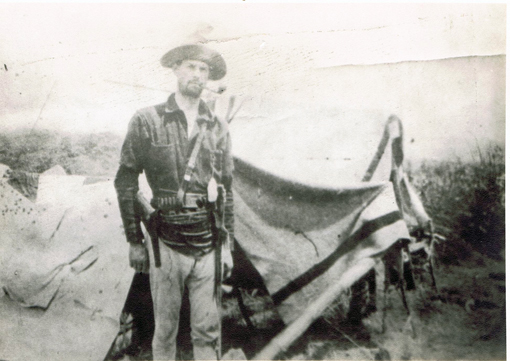
Capt. William B. Hill of Co E. Eighth Ohio During the Spanish-American War. Photograph taken at Santiago, Cuba.
On 15 July, the 136 men then enrolled were mobilized into federal service. The Tribune announced that they would be drilling 6 hours per day despite the fact that only 21 members had been provided with complete uniforms. By the end of July, Hill stated that recruiting was complete and that the company's 150 men would be ordered to a training camp shortly.
On 16 September 1917, for the second time in less than 20 years, Captain Hill again marched his troops to the train station. As in 1898, the city turned out in large numbers and with the assistance of the Ceramic City Band and the Grand Army of the Republic, Co. E was given a memorable demonstration of East Liverpool's affection for its boys in uniform
Co. E trained at Camp Sheridan, Alabama, where it was redesignated as Co. D, 135th Machine Gun Battalion, 37th "Buckeye" Division. Unfor-tunately, Captain Hill proved physically unable to meet the demands of active service and was given a medical discharge in January, 1918, due to high blood pressure and a weak heart. By June of 1918, the 37th Division was in France awaiting its first brush with the "Hun". A letter received from 1st Lt. Allen Surles on 5 August stated that the East Liverpool company was in a French village within sound of the big guns.
During the drive for St. Mihiel, the local company sustained their first casualties. Pvt. Howard J. Purinton, Pvt. C.A. Eardley, and Sgt. Charles C. Cox, the latter a veteran of Co. E in 1898, were killed. Three others were wounded - Lt. Lester B. McNicol, Pvt. Bernard Hanlon, and Pvt. Michael J. Payne, Jr.
The 37th Division was then transferred to the Flanders front in Belgium where the local men saw further combat and suffered further losses. Additional dead from Co. D included Cpl. Dan Duty and Pvt. Harry Heckathorne, both killed by the same German machine gun.
The return of Co. D to East Liverpool on 3 April 1919 was wildly celebrated, but that date also marks the last occasion when an East Liverpool military com-pany would return from war. Lessons learned during the First World War would forever terminate the nineteenth century concept of military units organized on a local level. The British had learned that such units could stimulate enlistments, as evidenced by the British "pals battalions", which were made up of men from one area. However, when, as in modern war, entire regiments were nearly an-nihilated, the effect proved disastrous on both the survivors and the communities from whence they came. That lesson was not lost on the Americans and never again would East Liverpool's citizens have the opportunity to create such units.

John Hughes, Cuba War, Co. E, 8th Ohio Nat. Guard. Taken by H. Webb. George Marshall Collection.
This site is the property of the East Liverpool Historical Society.
Regular linking, i.e. providing the URL of the East Liverpool Historical Society web site for viewers to click on and be taken to the East Liverpool Historical Society entry portal or to any specific article on the website is legally permitted.
Hyperlinking, or as it is also called framing, without permission is not permitted.
Legally speaking framing is still in a murky area of the law though there have been court cases in which framing has been seen as violation of copyright law. Many cases that were taken to court ended up settling out-of-court with the one doing the framing agreeing to cease framing and to just use a regular link to the other site.
The East Liverpool Historical Society pays fees to keep their site online. A person framing the Society site is effectively presenting the entire East Liverpool Historical Society web site as his own site and doing it at no cost to himself, i.e. stealing the site.
The East Liverpool Historical Society reserves the right to charge such an individual a fee for the use of the Society’s material.